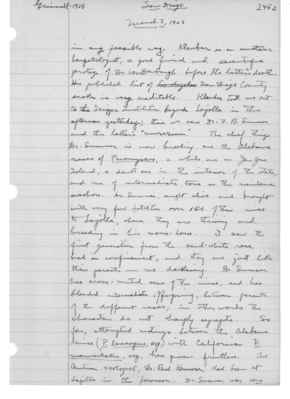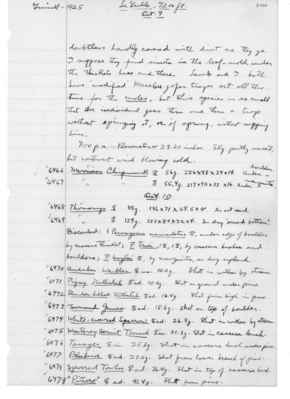Pages That Mention Peromyscus maniculatus
1925: Joseph Grinnell's field notes
S1 Page 3
Collector:Grinnell - 1925 Location: San Diego Date: March 3, 1925 Page Number: 2452
in any feasible way. Klauber is amateur herpetologist, a good friend and scientific protege of Dr. VanDenburgh before the latter's death. His published list of San Diego County snakes is very creditable. Klauber took me out to the Scripps Institution beyond Lajolla in the afternoon yesterday; there we saw Dr. F.B. Sumner and the latter's "murarium." The chief things Dr. F.B. Sumner is breeding are the Alabama races of Peromyscus, a white one in San Jose Island [unknown 4], a dark one in the interior of the state, and one of intermediate tone on the mainland seashore. Dr. Sumner caught alive and brought with very few fatalities over 150 of these mice to Lajolla, where they are thriving and breeding in his mouse-house. I saw the first generation from the sand-white race, bred in confinement, and they are just like their parents - no darkening. Dr. Sumner has cross-mated some of the mice, and has blended intermediate offspring, between parents of the different races; in other words the characters do not sharply segregate. So far, attempted matings between the Alabama (P. leucopus, ssp.) with Californian P. maniculatus, ssp., have proven fruitless. The Austrian zoologist, Dr. Paul Kammerer, had been at Lajolla in the forenoon; Dr. Sumner was very
S3 Page 37
Collector: Grinnell - 1925 Location: La Grulla, 7200 ft. Date: Oct. 9 Page Number: 2580
doubtless hardly covered with dirt as they go. I suppose they find the insects in the leaf-mold under the thickets here and there. Lamb and I both have "modified" Macabee gofer (sic) traps set all the time for the moles, but this species is so small that an individual goes thru and thru (sic) a trap without springing it, or if sprung, without nipping(?) him. 7:00 p.m. -- Barometer = 23.20 inches Sky partly overcast, but northwest wind blowing cold. 6466 Merriam Chipmunk (male sign) 56g. 226x98x34x14. Under boulder. 6467 Merriam Chipmunk (male sign) 55.4g. 217x90x33x16. Under manzanita. Oct. 10 6468 Thomomys (female sign) 88g. 196x71x29.5x4. In wet sand. 6469 Thomomys (male sign) 129 g. 225x80x32x4 In dry "second(?)bottom". Discarded: 1 Peromyscus maniculatus (male sign), under edge of boulder by cascara thicket; P. truei, 1 (male sign), 1 (female sign);by cascara bushes and boulders; P. boylii (male sign), by manzanita, on dry upland. 6470 Audubon Warbler (female sign) im. 10.0g. Shot in willow by stream. 6471 Pigmy Nuthatch (male sign)ad. 10.5g. Shot on ground under pine. 6472 Slender-billed Nuthatch (male sign) ad. 16.4g. Shot from high in pine. 6473 Townsend Junco (male sign) ad. 18.6g. Shot on top of boulder. 6474 White-crowned Sparrow (male sign) ad. 26.9g. Shot in willow by stream. 6475 Monterey Hermit Thrush (male sign) im. 21.8(?)g. Shot in cascara bush. 6476 Tanager (male sign) im. 25.3g. Shot in cascara bush under pine. 6477 Bluebird (male sign) ad. 27.0g. Shot from lower branch of pine. 6578 Spurred Towhee (female sign) ad. 36.4g. Shot in top of cascara bush. 6479 "Pinero" (female sign) ad. 91.4g. Shot from pine.

